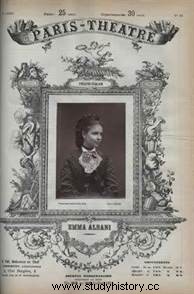 Between the 1840s and 1880s, the use of photography as newspaper illustration is indirect and slow due to poor print quality. Technical developments and half-tone will allow the transition from drawing to the integration of photography in the printing process. This press illustration is appreciated for its many qualities :its aesthetics, its informative and explanatory role. The clichés that create a close relationship with the reader serve as witnesses of reality. At the beginning of the 20th century, the first photographic agencies emerged , proof of the success of photography and the growing need for images. It is in the context of the golden age of the press, greater circulation of newspapers and technical progress that photography will become a coveted illustration.
Between the 1840s and 1880s, the use of photography as newspaper illustration is indirect and slow due to poor print quality. Technical developments and half-tone will allow the transition from drawing to the integration of photography in the printing process. This press illustration is appreciated for its many qualities :its aesthetics, its informative and explanatory role. The clichés that create a close relationship with the reader serve as witnesses of reality. At the beginning of the 20th century, the first photographic agencies emerged , proof of the success of photography and the growing need for images. It is in the context of the golden age of the press, greater circulation of newspapers and technical progress that photography will become a coveted illustration.
The first uses of photography in the press
Before being integrated directly into the print, the photograph serves as a document and model for designers and engravers. Used as “visual raw material », it is a valuable tool for designers who take pictures in order to copy them manually. Secondly, the engravers interpret and integrate the image into the publication by means of mechanical impressions such as lithography (made on limestone) and woodcut.
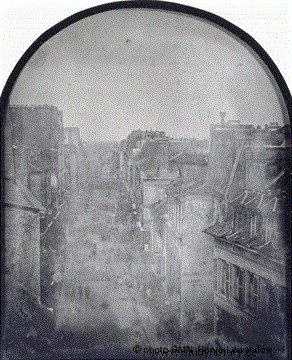 In 1843, the year of its creation, L'Illustration, illustrated weekly, publishes his first woodcut made from a daguerreotype and which reveals the political unrest in Mexico. The daguerreotype is the first photographic process invented in 1839 by Daguerre to fix the image on a silver plate. Among the most famous covers of the newspaper, there is also that of the barricade of Saint-Maur published in June 1848. Other illustrated newspapers use photography. Following the photographic mission of the explorer Desiré Charnay, carried out in 1857 in Mexico, photos are broadcast in Le tour du monde in 1862 and Le monde Illustré in 1865.
In 1843, the year of its creation, L'Illustration, illustrated weekly, publishes his first woodcut made from a daguerreotype and which reveals the political unrest in Mexico. The daguerreotype is the first photographic process invented in 1839 by Daguerre to fix the image on a silver plate. Among the most famous covers of the newspaper, there is also that of the barricade of Saint-Maur published in June 1848. Other illustrated newspapers use photography. Following the photographic mission of the explorer Desiré Charnay, carried out in 1857 in Mexico, photos are broadcast in Le tour du monde in 1862 and Le monde Illustré in 1865.
It is important to note that it was not until the 1860s that photography was recognized in the press as a model of illustration. Indeed, it was during this period that the mentions "from photography appear more frequently at the bottom of captions. This mention formalizes the use of the photograph and also makes it possible to certify the accuracy of the reproduced image.
In the case of subscription weeklies and limited editions, photographs may be pasted On paper. This is particularly the case of theater newspapers which are the equivalent of the current programs of theater performances. The magazine Paris-Théâtre offers in insertion out of text, plates printed in photoglypty. It is a mechanical reproduction process invented by Woodbury in 1864 which has continuous tonal gradations. Each week, the newspaper presents the portrait of an artist with his biography on the back.
Towards a better reproduction of photography:the laminated wood technique
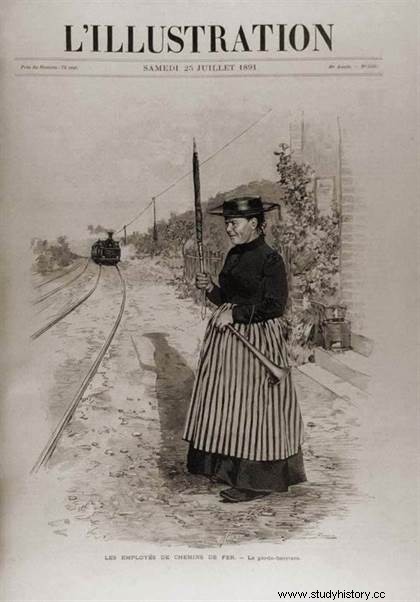
The photograph taken by the process of wood engraving has long remained a means of illustrating with portraits, characters or defendants during legal cases, such as that of Marshal Bazaine in 1873, or the Dreyfus Affair in 1894. Improvements in engraving processes will accentuate this trend . The engravers will become retouchers to work on the image and give it more contrast.
Ernest Clair-Guyot , cartoonist at l’Illustration since 1883, invents the technique of film-coated wood which makes it possible to directly reproduce the cliché on wood, in order to be engraved without the intermediary of the drawing . According to him, this new process is very practical “Instead of copy on the wood the photograph which served only as a document, I used the proof even while retouching it directly , which gave my drawing all the precision of the cliché, and when my work was finished, it was photographed on the sensitized wood for the engraver. Result:great time saving since, instead of copying the entire photograph on the wood, we only improved and finished it ". This technique would have been used for the first time with “La garde-barrière” (Left image).
Nevertheless, the caption of the image does not specify the technique used and even if it can be confused with a photograph, it would be more of an engraving. Thierry Gervais' thesis entitled photographic illustration , sheds light on the characteristics of this illustration "Ambroise-Rendu presents the image of Clair-Guyot as a key moment, a turning point in the history of photography in the press when the film-coated wood technique produced a image whose hatch network certifies that it is in the engraving mode .
From halftone engraving to the first photographic magazines
At the end of the 1880s, technical progress in halftone engraving marked the entry of photography into the press . This technique is the result of the work of Charles-Guillaume Petit in France and Georg Meisenbach in Germany. By combining text and image on paper, the halftone “uses a screen to divide photographic tones into dots” in order to preserve the forms of the photograph and without going through the work of the engraver.
The photographic interview by chemist Michel Chevreul by Nadar published in Le journal illustré of September 5, 1886 would constitute the "first attempt at transparency" and faithful publication of photos. It testifies to this new need for more real and lively illustration offered by photography. This is the first photographic report embedded in a journal. The photogravures published there are very well printed and respect the details of the photograph. World events also favor the increase in the publication of photos. This is the case with British illustrated weeklies such as the Graphic, who publishes a large number of photographs taken during the Boer War in South Africa between 1899 and 1902. Photo reports thus increase newspaper sales because these world events fascinate readers who have a broader view of the world.
Dailies are gradually starting to publish prints, like the British Daily graphic and the Daily Mirror. In 1900, TheChicago Tribune, American daily newspaper, devotes entire pages to a photographic report made in the slums of New York. In France, four major daily newspapers engage in fierce competition around photographic illustration through illustrated supplements. Thee Little Diary and The Diary each created an illustrated supplement in 1890 and 1983.
The Little Parisian increases its pagination and the Morning published photos as early as 1902. Between 1880 and 1908 the circulation of these dailies increased considerably, from 2,000,000 copies in 1880 to 4,777,000 in 1908. In addition, new illustrated dailies were created. This is for example in 1910, the case of Excelsior, which makes extensive use of photographs. Smaller in format than other dailies, it adopts the new popular magazine formula “newspaper made for those who cannot read”. It features over twenty shots per issue and even contains full-page photos.
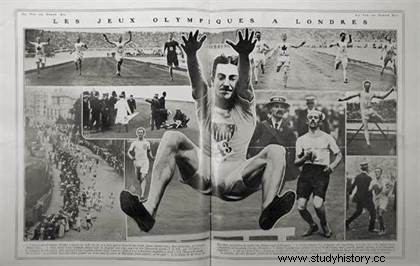
Photography sells and generates great competition. Like American magazines, such as Harper’s weekly which publishes photojournalism, and British newspapers such as the Photographic News in 1858, photographic magazines French and German arrive in circulation. These will take up the concept of almost exclusively photographic illustration and will always be printed on quality paper, coated or even glossy, favoring the aesthetics of the layout and illustration.
The new photographic magazines are both generalist like Berliner Ilustrierte Zeintung created in 1891 and The Illustrated Life in 1898 and specialized as Life in the Great Outdoors in 1898 and Fémina in 1901. Life in the Great Outdoors is a sports magazine composed of 16 pages and 70% illustrated. Subsequently, rotary gravure printing favored the creation of a second wave of photographic magazines which began with the Mirror in 1913. This is a printing technique suitable for long runs. Photography has a major place here in these magazines with variable formats and diverse content adapted to the public.
The limits of integrating press photography
The circulation of photographs is a major obstacle, especially for daily newspapers. From 1850, the photos arrive by rail several days after the event, which makes them timeless , late on the news. To use photographic illustration, an event would have to remain in the news for several days (like the various wars) or take place near an editorial office. However, when it comes to sudden events, the newspapers have recourse to the traditional cartoonists, who reconstruct the event from memory. The use of photography is therefore random, especially since the telephotography, system of transmission by electrical signals, has been used sporadically since 1907. It will only take off after the Great War.
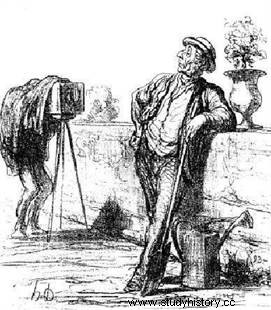 The success of photographic illustration engendered dissatisfaction among designers and engravers. Cohabitation is difficult . Thus, the satirical press rejects photography and makes fun of it. Indeed, caricatures have been made against the photographers, in particular those published in the Charivari by Daumier, painter and engraver. Honoré Daumier denounces the fact that photography can enhance the rank and wealth of the man who poses. Other caricatures are published in the satirical newspaper:Le rire . The engravers who competed with the photographers by retouching and embellishing the basic photograph, contributed to the delay of its direct and mechanized exploitation.
The success of photographic illustration engendered dissatisfaction among designers and engravers. Cohabitation is difficult . Thus, the satirical press rejects photography and makes fun of it. Indeed, caricatures have been made against the photographers, in particular those published in the Charivari by Daumier, painter and engraver. Honoré Daumier denounces the fact that photography can enhance the rank and wealth of the man who poses. Other caricatures are published in the satirical newspaper:Le rire . The engravers who competed with the photographers by retouching and embellishing the basic photograph, contributed to the delay of its direct and mechanized exploitation.
The new French illustrated dailies that are created with extensive use of photography, such as the Illustrated Daily or Excelsior suffer a failure. The latter can be explained by French cultural habits which, unlike American habits, favor writing and reading images in daily newspapers. Magazines have had an easier time due to their more entertaining and popularizing vocation. These failures show the rejection by an educated category of the population of photographic illustration in favor of the text. Readers considered that photos, like headlines, took the place of text.
Thus, if at the beginning of its use, the photograph is reduced only to that of simple model , it will then be integrated directly into the printing process using photoengraving. Moreover, following the numerous photo-reports carried out during the various world events of the beginning of the century, a new socio-professional category will emerge, it is the photographer reporter Press. This enthusiasm for photographic illustration and the ambition of publishers would help give rise to newspapers specially illustrated by photography such as the first photographic magazines.
The illustrated press, which used drawings more, adapted and competed with the new magazines by also integrating clichés. The newspaper L’Illustration ranks first in the world for the illustrated press with 280,000 copies sold on the eve of the First World War. The year 1914 will constitute a rupture insofar as the First World War will considerably increase the production of photographs to manipulate the reader through the "cramming .
Bibliography
- - De BAJAC, Quentin, The Revealed Image, the invention of photography. Gallimard, 2001, 159 p
- - De BAJAC, Quentin, Photography, the modern era 1880-1960. Gallimard, 2005, 159 p
- - By FEYEL Gilles, La Presse in France from the origins to 1944 . political and material history. Ellipses, 2000, 192 p
